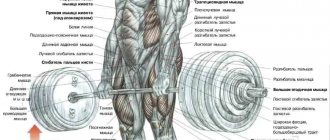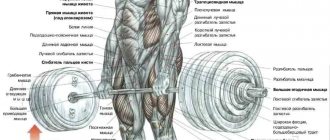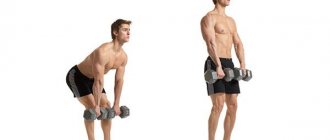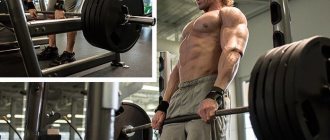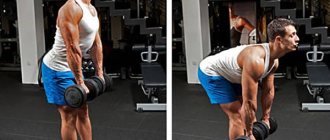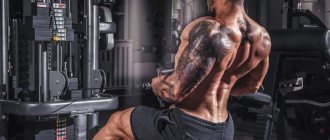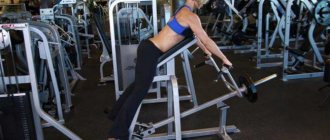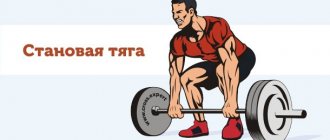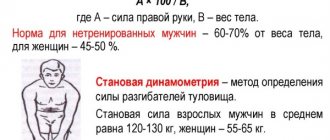Hello friends ! Hello athletes of all genders and nationalities (the main thing is that they understand Russian).
Vitaly Okhrimenko is still on the line, and today we will try to delve deeper into the study of deadlift. Today's publication is not very suitable for green beginners, although it is useful for them in the future. But rather, it is still aimed at experienced, kind of seasoned jocks who have been doing deadlifts for a long time, but do not know how to increase their deadlift.
And although the tips that I will give in today’s publication are more aimed at average athletes (who are the majority in any gym), they will also help professional powerlifters because the principle of increasing strength in the deadlift is the same for everyone.
So if you don’t mind taking advice from a guy whose personal record at the time of publication is only 180 kg at once, then get ready to remember cool and practical advice. And please don’t forget to share your thoughts and successes in the comments.[contents]
How to increase your deadlift
I hope it is clear that now we are talking about how to increase the classic deadlift. The classic deadlift is in fact one of the golden three exercises of bodybuilding, and besides, it is the basis of powerlifting and weightlifting. What can I say, separate competitions have been held among lifters for a long time specifically in deadlifting as a separate discipline of powerlifting.
For us, natural bodybuilders (especially amateurs who lift “for themselves”), on the one hand, it seems like we don’t really need to lift exorbitant weights in the deadlift. On the other hand, you still need to know how to improve and increase your deadlift performance.
I will not re-list all the advantages that the classic deadlift brings; I have already done this in detail here. It’s better to get down to business and finally find out how you can increase your results in deadlift.
To pull a lot you need to pull
Now I don’t claim the status of “getting the chip on fire,” but still... If you have a great desire to increase your deadlift, you need to do it a lot and persistently. In order to increase your deadlift, you need to do it at least once a week.
Let’s say you do it 1 time for 1 week, and do it 2 times the next week. As a result of simple calculations, we received 6 lifts per month. And now the trick: we do 3 of them in a power style (2-5 repetitions), and the other 3 times we alternate the following options:
- Romanian deadlift;
- deadlift Sumo;
- turning lagging muscles;
- speed version of the deadlift;
- deadlifting with harnesses or springs.
Fight the weakest links in your deadlift
To increase your deadlift, it’s not enough to just do it alone. The fact is that doing deadlifts alone will not lead to pumping up all the muscles necessary to increase performance in the classics.
The deadlift uses about 80% of the muscles of the body, but we directly influence all these muscles in different ways by performing the classics. That is why, in order to improve your results in the deadlift, you need to pump up all the auxiliary muscles. In fact, this is the main emphasis of today’s publication.
What muscles work in the sumo deadlift?
Main muscles:
- Quadriceps femoris muscles.
- Adductor muscles of the thigh.
- Gluteal muscles.
- Lumbar extensors.
Accessory muscles:
- Trapezius muscle.
- Latissimus dorsi muscles.
- Rhomboid muscle.
- Deltoid muscles.
- Pectoral muscles.
- Abdominal muscles.
- Forearms.
- Biceps.
Speed deadlift variation
To increase your deadlift results, you must perform explosive deadlift variations from time to time. In principle, everything is simple: we do the same classic deadlift, only we do it specifically with light weight, many repetitions and quickly. What is called explosive style.
For the speed version of the deadlift, we take 40-60% of the working weight and perform deadlifts in an explosive style. Fast and a lot. In this case, you need to take into account the fact that speed should not affect quality. The technique should still be perfect and the bar should not bounce off the floor.
Features and Benefits of the Sumo Deadlift
The peculiarity and main difference between sumo-style deadlifts and others is the wide placement of the feet. This technique allows you to connect and direct the load to the adductor muscles of the thigh, which is impossible to achieve when placing your feet shoulder-width apart, especially in the Romanian deadlift technique.
Due to the large distance between the feet, the amplitude of movement is reduced and the main part of the load falls not on the back, as in a classic deadlift, but on the quadriceps, adductors and gluteal muscles.
Deadlift problem areas
In order to increase your performance in the classic deadlift, you need to work on problem areas (I hope it’s clear that I’m not talking about cellulite on the ass or fat on the sides
). This means working on problem areas that may prevent you from reaching a new level in deadlifting. These places are different for everyone, and they depend on a whole bunch of different factors:
- on body type;
- on the level of training;
- on the ratio of muscle pumping.
Therefore, in order to improve your results, you need to work on these most problematic areas. We empirically determine which phase of the lift is more difficult and eliminate these problem areas using the following recommendations:
The problem is the starting position
If the most difficult thing is to lift the barbell off the floor, then you need to work on this place. In the lower part, most of the load falls on the gluteal muscles. It is clear that at this moment you need to work on strengthening the gluteal muscles + working on the lower (starting) phase of the movement.
To work the lower part of the movement, it is best to perform deadlifts from an elevated position. To do this, put a pancake on the floor (two are possible), stand on it and perform the classics. There is no need to climb onto parapets or stands that are too high (25–40 cm); a starting position that is too high will put excessive stress on the lower back at the moment of takeoff, and this is dangerous. 5–10 centimeters will be enough. The weight in this case is 80–90% of the working weight.
There are also options for traction to the knees or statics. When rowing to the knees, we load the barbell with 10% more weight than our working weight, and do only the lower part of the amplitude, i.e., we work on lifting and moving the barbell from the floor to the knees. We perform statics with a weight 15–25% less than the working one, bring the bar slightly lower than to the knees and stay in this position for the maximum possible time.
Both when performing the lower part of the deadlift, and when performing statics, you need to monitor the technique as accurately as possible. As soon as the technique begins to break down in any way, in the first case you need to stop the exercise or lose weight, in the second case you need to immediately lower the barbell to the floor. Health is more valuable than the intermediate result!
Problem when passing knees
As you pass the knees in a classic deadlift, you simultaneously extend your legs and straighten your back. And if the back extensor muscles (also known as the lumbar muscles) do not have sufficient strength, then this moment can be difficult and create obstacles on the way to new personal records in the deadlift. In addition, the lumbar spine is most at risk when performing deadlifts, so the back extensor muscles need to be strengthened anyway.
The best ones for this are:
- hyperextension;
- standing on straight legs;
- “good morning” exercise (bending over with a barbell on your shoulders);
- deadlifting from high racks or plinths.
Let's look at the technique
classic deadlift.
We place our legs slightly narrower than our shoulders, feet parallel. We grab the bar at shoulder width. The barbell is raised in such a way that the bar slides along the shins.
You are in a squat position in front of the barbell. The back is tilted forward, but at the same time straightened at the waist. The thoracic region is also extended (chest like a wheel).
At the beginning of the movement, leave your back in a stationary position and pull the barbell up using the power of your legs . This is one version.
If you have a stronger back, then slightly raise your pelvis from a full squat position and make the first movement of lifting the barbell using the strength of your back .
Video.
You need to lift the projectile off the floor and straighten up completely. We do not bend our back while moving.
If your knees get in the way when lifting the barbell, then you need to slightly tilt your body forward.
There is no need to move your hands around your knees.
If the weight is heavy, this movement will be impossible. There is no need to move the projectile with your hands at all. The arms “hang like whips” from the shoulders. But of course they are not relaxed, but hold the bar tightly.
If your knees get in the way when lowering the barbell, then you need to stand in the upper position and, starting to lower, tilt your torso forward just enough so that your knees do not interfere with the lowering of the apparatus.
But with such a slight tilt, do not forget to keep your back straight. You bend at the hip joint, not at the lower back.
Accordingly, if the bar goes far (more than 2-3 cm) from your shins when raising and lowering, it means you are leaning forward too much. Then you need to keep your torso more vertical.
The speed of the exercise is slow, without jerking. The first two months we practice movement techniques. Under no circumstances should you train with heavy weights.
It is better to select the starting weight so that you can do the exercise 15 times. Do 3 x 10 with this weight. And so train for two months only on technique. The large weight of the projectile will distort your technique , and you will learn to do the exercise incorrectly.
Once the technique is mastered, you can increase the weight of the barbell and reduce the number of repetitions.
Usually deadlifts are done 5*5 or 5*8. Those. five sets of five (or eight) reps per set.
I will create a training program for you.
Of course, it is difficult to hold a heavy bar in your hands. Therefore, in order to fully concentrate on lifting the barbell, and not be distracted by holding the bar, be sure to perform the exercise with belts or straps. We use them to fix our hands on the barbell.
In competitions, the exercise is performed without straps on the arms. But there the bar rises only once. And the strength of the brushes is quite enough.
If you want to strengthen your grip , then it is better to do this not while performing deadlifts (although even with straps, your grip will strengthen). And other exercises.
For example, hanging on a horizontal bar for a while. And for those who are especially strong, the horizontal bar can be wrapped in a towel.
During the exercise you need to use a weightlifting belt.
Thus, let us formulate the technique
correct deadlift .
1. The back in the deadlift should remain level throughout the entire movement.
2. In the starting position, the pelvis can be raised higher or lower depending on the individual characteristics of the athlete.
3. The direction of the starting force is backward and upward.
4. The projection of the center of gravity passes through the heels.
5. The pace of the deadlift is slow and steady.
6. The position of the legs is slightly narrower than the shoulders, the feet are parallel to each other.
7. The grip of the barbell is shoulder-width apart or slightly wider. In competitions they use different grips.
Advice from Alexey Faleev.
If you have back pain, severe curvature of the spine or other back problems, then consult a good manualist or sports doctor about whether you can even do squat deadlifts.
Before each approach, apply chalk or magnesium to your hands to more confidently hold the barbell.
Always use locks on the barbell when performing deadlifts . Actually, locks should always be worn. I don’t do a single approach without locks.
This is necessary so as not to worry about the pancakes moving off the bar. At the moment of recovery, such thoughts should not distract your attention and bring down your mood.
Both during lifting and while lowering the barbell, you should not put your body weight on your toes. This would be a mistake. In this case, the bar will move forward from your legs and you may get injured.
Don't do deadlifts off the floor. This makes your work much easier and passes the critical point of removing the barbell from the platform at speed. The meaning of such training disappears.
Additionally, "bouncing" can cause the plates on one side of the bar to bounce off the floor faster than those on the other side. This will cause you to lose control of the barbell, lift the weight asymmetrically, and cause an uneven load on your body.
And this is fraught with serious spinal injuries.
Never twist your head when you lower or raise the barbell - the barbell may tilt slightly to the side, you will be pulled to the side, and you may injure yourself.
If you feel that you cannot lift the barbell, do not throw it. Lower it onto the platform, if possible, smoothly, so that the load from your back is removed not abruptly, but gradually.
Sudden removal of the load can seriously injure the muscles of the back, elbows or shoulders. Moreover, it is even possible that at first you will not feel anything, but this will manifest itself after a couple of days.
Never repeat this to failure. Never perform forced or negative reps. In such a serious exercise as deadlift , these experiments are not appropriate.
Do not perform deadlifts if your lower back muscles are still quite sore from your last workout or even from regular heavy physical labor. Rest for a day or two and wait until the muscle pain goes away.
It happens that on large scales the pressure jumps greatly after the athlete moves away from the bar after performing the exercise. In this case, before performing the exercise, it makes sense to tighten the elastic bandage on your head tightly. Pressure changes will be felt less acutely.
To collect yourself before the next approach and tone your muscles, you can use ammonia. In general, ammonia should always be in your sports bag along with warming ointment, a towel and sportswear.
Assistance exercises to improve deadlift results.
1 Deadlift while standing on a stand, or deadlift. This thrust is almost no different from the classic version. You just need to place a stand with a height of 5 - 10 cm under your feet. This exercise is necessary in order to practice a powerful, confident pull of the barbell from the platform, because. here it is the 1st phase of traction that is significantly more complicated. For simplicity, you can place one or two rubberized disks under your feet. It is recommended to periodically change the height of the stand.
2. Pull from plinths (from stand). The technique of execution is the same as in the classic deadlift, but now the barbell stands on a stand 5 - 15 cm high. This exercise works on the 2nd phase of the deadlift movement, that is, fixation. It is also important because here you can lift the weight more than 100%. (The higher the plinths, the more weight you can lift.) This is especially true for deadlifts - summo. In this way, you become accustomed to the weight, and this is very important in deadlifting.
3. Hold. The technique of this exercise is simple. The barbell is brought to the top position and you hold it in a fixed position for about 10 seconds. The weight here should be large - 120-140% of the maximum thrust. Straps are necessary for this exercise because otherwise you will tear the skin on your palms. But even with straps, this will be a serious test for your hands. This exercise greatly strengthens the trapezius and helps to practice fixing the barbell in the upper position.
4. The pull is slow. This is a regular classic deadlift (of the appropriate style) that must be performed at a slow pace. Several options are possible:
a) 3 sec. movement up + 3sec down;
b) 5 sec up, + 5 sec down;
c) 10 sec up, + 10 sec down. .
Depending on the traction option, the appropriate load and number of repetitions are selected. This deadlift will help you improve your movement technique.
5. Traction with stops. An ordinary deadlift, but it gets done. Not at a progressive, even pace, but with 3-4 stops:
1st - 2-5 cm from the platform (moment of separation);
2nd - just below the knees;
3rd - just above the knees
4th – fixation
The stop is carried out for 2 – 5 seconds. Stops can be made when moving up or down or up and down. The number of repetitions is no more than three (since the approach time will still be quite long). This exercise will help you practice your technique, teach you to pass the dead point and endure the load if the barbell suddenly gets “stuck” in movement.
6. Pull to the knees. This traction is in addition to traction from the plinths. It helps you practice lifting the barbell from the platform and going through the first part of the deadlift movement. Usually at the top point (at knee level) a delay is made for 3-5 seconds (isometric load). You can combine this row with a row on a stand and make one, but more intense. That is, perform deadlifts to the knees while standing on a stand. This helps those who have problems removing the barbell from the platform.
7. Isometric (static) traction. This is an isometric load that works to get past the dead point in the deadlift. It is necessary to set the barbell at the level of your dead center in the deadlift (on a platform or on a stand). Set the weight of the barbell to a weight that you know is greater than you can lift, and perform isometrics in this position while trying to lift the barbell. Approach times may vary:
a) 5 times for 3 seconds;
b) 3 times for 5 s;
c) 1 time per 10 s, etc.
Other options are possible, but the above are the most common. It is recommended to perform this exercise next after the classic deadlift. You can use a belt, but do not use straps.
8. Negative. Negative thrust movement. Used quite rarely. Serves for developing movements with large (about or more than 100%).
Help for improving deadlift results
The main muscles involved in the deadlift are the back extensors, hips, glutes, latissimus dorsi, trapezius and to some extent the forearms. Therefore, you need to not only work on problem areas, you need to pump up all the muscles that work when performing deadlifts. I’ll be brief and list exercises that should at least sometimes appear (or better yet, appear often) in your training program.
Necessarily:
- Squats with a barbell to parallel.
- Deep (lifting) squats.
- Romanian deadlift.
- Deadlift.
- Pull-ups.
- Bent-overs with a barbell.
- Bent-over barbell row.
- Sumo deadlift.
Preferably:
- Front squats.
- Block pull between the legs.
- Bulgarian squat.
- Zercher squats.
- Lower block thrust.
- Pulling the block to the chest or from behind the head.
- Deadlift from plates.
- Traction with increased amplitude.
- Hack squats.
What kind of exercise is this
The deadlift is one of the best exercises for gaining overall muscle mass. Beginners to the sport unreasonably consider its implementation too dangerous and difficult, so the priority is complexes for the chest and biceps muscles. In part, these fears are true. Doing the exercise incorrectly can lead to dangerous back injuries.
The sumo deadlift is aimed at creating strong muscles in the legs and back, without which it is impossible to fully pump up the body. The exercise is included in the basic training complex for bodybuilders. The technique involves lifting the barbell from the floor with legs wide apart to waist level and returning the barbell to its original position.
The complex, in addition to bodybuilding, is used in functional circuit training (trap bar deadlifts), powerlifting and other strength sports. Deadlift contributes to the maximum strength load of athletes and unlocks their potential before great strength records.
Pump up your abs
It is also important to remember that when performing a deadlift, the abdominal muscles are very actively involved. In fact, they are the first to tense up when performing a deadlift, and poor abs can become the second cause of spinal injury (after incorrect technique). Therefore, you must always remember: if you want to increase the results of your deadlift, you need to work hard on your abs!
Moreover, you need to pump both internal (invisible) and external (visible) abdominal muscles. Therefore, include in your program all the abdominal exercises you know. This definitely won't make the cravings any worse!
The benefits and harms of exercise
Deadlifting involves almost all muscles - legs, back, arms, abs, shoulders, promoting their growth and strengthening. In addition, the central nervous system is strengthened. Advantages of the exercise:
- Actively builds muscle mass.
- Strengthens the back and spinal trunk.
- Actively works on the muscles of the lower extremities and buttocks.
- Increases overall physical strength.
Use light weights to hone your technique.
Contraindications
Contraindications for deadlifts include:
- Injuries of the upper and lower extremities.
- Phlebeurysm.
- Received or congenital spinal injuries.
- Curvature of the spinal column.
- Adolescence.
Grip problems
Regarding the grip and use of the straps, I have given my opinion here. However, there is one catch: the advice of using straps at higher weights is a good way to improve deadlift performance for those guys who cannot deadlift competitively. But guys who need to increase their deadlift in order to break everyone in powerlifting competitions should also work on their own grip to improve their deadlift results.
Working with straps does not improve grip strength (quite the opposite). Therefore, in order to improve the deadlift for competitions without equipment, it is imperative to work with the deadlift without straps.
First of all, for this you need to perform all traction exercises without the help of straps + regularly knead the hand expander. Sometimes perform static exercises of holding a barbell in your hands. Well, your forearms need to be pumped up from time to time, because their strength is also directly related to tenacity.
Newbie mistakes
Below are the most common mistakes of inexperienced athletes that you can observe in the gym. If you recognize yourself in any of these areas, seek the help of a qualified personal trainer to correct your technique and prevent possible injury.
- Use the correct deadlift shoes. Barbells are a great thing, but they are more suitable for squats, snatches and clean and jerks; for deadlifts you need shoes with the thinnest possible soles - this way you will shorten the amplitude, and breaking the barbell will be easier. The ideal option is wrestling shoes; they have a thin but rigid sole.
- The bar is too far from the shin. This will make it much more difficult for you to control the position of the body, since the bar will change.
- Using wrist straps and an athletic belt , starting with light weights. Yes, using this equipment makes the task somewhat easier, but it is advisable to learn the correct technique without using it.
- Do not place your feet too wide if you do not have enough stretch for this - this way you risk developing a sprained adductor muscle.
- The back should remain straight throughout the entire exercise. Rounding of the lower back or hunching is unacceptable.
- Respect long-standing traditions - do not step over the bar . Many people think this superstition is stupid, but by not stepping over the bar you will earn credibility with the “old-timers” of the gym. The tradition dates back to the Soviet school of weightlifting, but is still relevant today.
Principle of progression
Of course, in order to increase traction performance, you need to constantly increase weight. Make it a rule: add 5 kg to the barbell twice a month. If adding is easy, then add 5 kg 4 times a month. Get to your maximum (when it will be almost impossible to add), and still continue to add, just less often.
You can only progress when you constantly and systematically move towards it. Always try to pull out more, but first read the next point.
Don't tear your belly button, it's not a solution
If you are a non-professional powerlifter, then figure out your 1MB (maximum weight for one repetition), and return to it from time to time. Add the above 5 kg only after WW1 has been successfully overcome.
At the same time, you don’t need to set yourself up for unsuccessful repetitions. If you didn’t succeed in some weight either the first or the second time, lose 5–10 kg and work with this weight as with WW1 for several weeks. At the same time, do not forget that you need to touch this 1MB extremely rarely, no more than 1-2 times a month (I repeat: if you are not a lifter). Maximum attention to the weight with which 4-6 repetitions are obtained in the approach.
Training Tips
A coach will help you achieve good results in sports. He can promptly point out possible errors and correct them in a timely manner.
Warm-up
The warm-up begins with an empty bar to warm up the muscles. After completing 10-15 repetitions, you can put on plates, gradually increasing the weight. Number of approaches: 3-4 times, 6-8 repetitions.
Equipment
To perform deadlifts, professionals use special equipment. Is it necessary for beginners? In the exercise, it is not the weight lifted that is important, but the correct execution of the complex. Using belts and a belt is not at all necessary if you do not strive to become a champion in the number of kilograms lifted. The equipment makes it easier to hold a lot of weight in your hands. But pay special attention to shoes. The best models have the thinnest soles. It does not absorb shock and it will be much easier to tear the bar off the floor due to the shortening of the amplitude.
Weight
The weight of the burden is added gradually. You should start with a small comfortable weight, increasing the load over time. Muscles must adapt, otherwise a sudden increase in load will lead to serious injuries, even if there is nothing to indicate future problems on the day of training.
Sets and reps
In different strength sports, the number of approaches and repetitions is calculated according to a specific program. Beginner athletes are limited to one workout per week, 3-4 sets with repetitions 6-8 times and a weight of 50% of the maximum.
More advanced athletes, when working for strength, perform from 3 to 6 approaches of 4-6 repetitions with 90% of the weight of the one-time maximum, and when working for mass - 4-5 approaches of 8-12 repetitions and a working weight of 60-65% of the one-time maximum maximum.
Nutrition and sports supplements
Proper nutrition is important in sports. It must be correct and balanced. A calorie deficit will not result in active muscle growth.
Sports nutrition today is becoming increasingly popular, both among professionals and beginners.
Particular attention should be paid to supplements, such as protein, gainers, protein shakes. They ensure optimal muscle growth with regular exercise in the gym.
How to increase your sumo deadlift
To lift more weight on the barbell when performing the sumo technique, you need to give the barbell a certain acceleration. To do this, it is worth training the explosive strength of the leg muscles using special exercises (squatting on a bench with a delay in the lower position, long jumps, jumping onto a box). At the same time we strengthen our back. The following complexes are suitable: slopes with a barbell or shrugs with dumbbells.
Pump your legs separately
The same squats on one leg, Bulgarian squats, lunges, scissor squats - in general, all exercises that pump the legs separately will definitely have a positive effect on the results of the deadlift. The fact is that when performing exercises on one leg, those muscles are pumped that do not work when performing exercises on two legs. Therefore, sometimes you need to do exercises on one leg.
